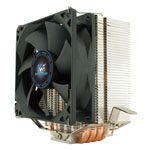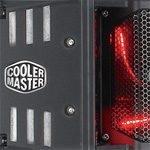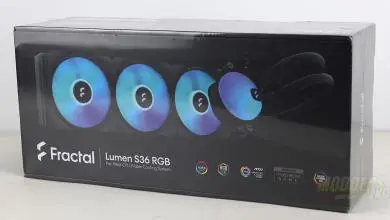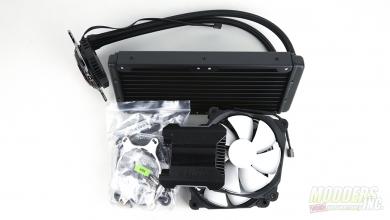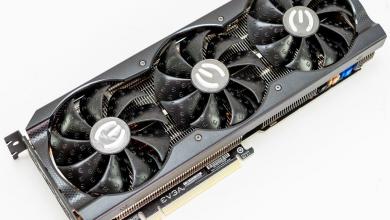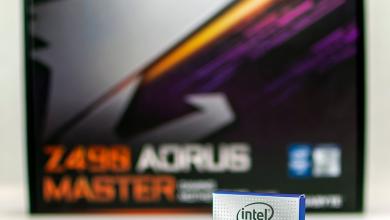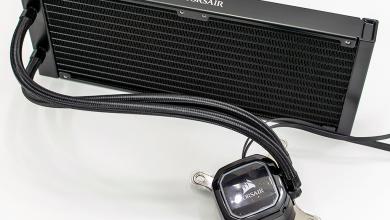Noctua NH-U14S CPU Cooler Review: An Exercise in Efficiency
Test System and Benchmark Results of the Noctua NH-U14S
Ambient temperature monitored at case intake and temperature Delta was used. All case and heat sink fans were benchmarked with fan control settings disabled and running at 100% unless otherwise specified. Intel integrated video is utilized to eliminate additional ambient heat source from discrete graphics cards. Temperatures are averaged (last minute) from individual core temperature results monitored by AIDA64 after 15 minutes. FPU load average is used to simulate worst case scenario load levels similar to Intel Burn Test or OCCT, results marked “0″ means thermal limit was reached and the CPU was throttled and thus the results were discarded. Stock settings have all power saving features enabled in the motherboard with Vcore set static to 1.1V and set to “Balanced” in the OS. Overclocked settings have Vcore voltage manually set to 1.2V at 4.2GHz and 4.4GHz with EIST disabled. All tests were taken at least three times to get the final result.
| Processor | Intel Core i7-4770K (Retail) |
| Motherboard | ASUS Maximus VI Gene Z87 Motherboard |
| Memory | Patriot Viper 3 “Black Mamba” Low-Profile 2x8GB DDR3 Memory |
| Drive | OCZ Agility 4 256GB SSD |
| Video Card | Intel Integrated Graphics |
| Thermal Compound | Noctua NT-H1 |
| Case | Cooler Master HAF XB (open air test-bench mode, all fans removed) |
| Power Supply | Corsair HX850W |
| Operating System | Windows 7 x64 Pro |
| Comparison Heatsinks | Noctua NH-U14S |
Phanteks TC14PE |
Be Quiet Dark Rock Pro 3 | Noctua NH-D15 | Noctua NH-D14 | Cooler Master Nepton 140XL |
| Fan Size (mm) | 140mm |
140mm x 2 | 135 and 120mm | 140mm x 2 | 140 and 120mm | 140mm x 2 |
| Max fan RPM | 1500 | 1200 | 2100 and 1500 | 1500 | 1200 and 1300 | 2000 |
| PWM | YES | NO | YES | YES | NO | YES |
| Fan Bearing Type | SSO2 | UFB | FDB | SSO2 | SSO2 | Rifle |
| SLIM | YES | NO | NO | NO | NO | – |
| Direct-Heatpipe | NO | NO | NO | YES | NO | – |
| Heatpipe Thickness (mm) | 6 | 8 | 6 | 6 | 6 | – |
| Heatpipe Count | 6 | 5 | 7 | 6 | 6 | – |
| Radiator Size |
– | – | – | – | – | 171 x 139 x 38mm |
| Radiator Material |
– | – | – | – | – | Aluminum |
| Price (in USD) | 75 | 99 | 80 | 99 | 82 | 99 |
Benchmarks:
Results marked “0″ means thermal limit was reached and the CPU was throttled
Fan Sound Profile:
As powerful as the Noctua NF-A15 fans may be, it is able to push air without overwhelming the ears. The only weakness of the fan is when it is placed in the rear as a “pull” fan, where it will produce a high pitched sound caused by the turbulence at high speeds. This is why Noctua provides an alternate padding in the accessories for secondary fans which provide more gap between the optional rear fan and the NH-U14S body, effectively minimizing turbulence and noise. On the test selection, the CM Nepton 140XL is at the top although it has the loudest fans while the Dark Rock Pro 3 is the most silent (despite running at high-RPM) and has the warmest temperatures. The NH-U14S with an extra fan is slightly louder than the NH-D14 but is still within considerably quiet range.
Performance Summary:
The NH-U14S had an impressive showing both with and without the optional retail NF-A15 “pull” fan. On our open-air flat surface test bed, it performed better than the NH-D14 even when the i7-4770K was overclocked which was remarkable considering its size.



